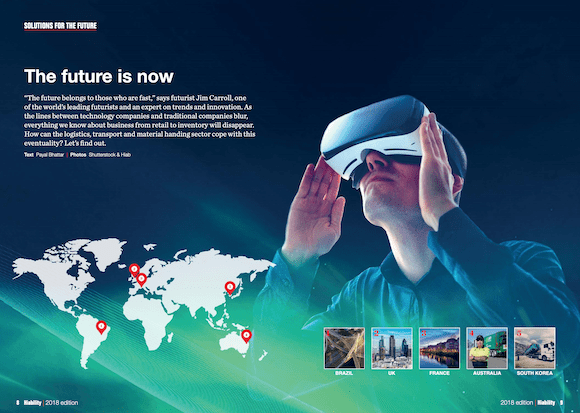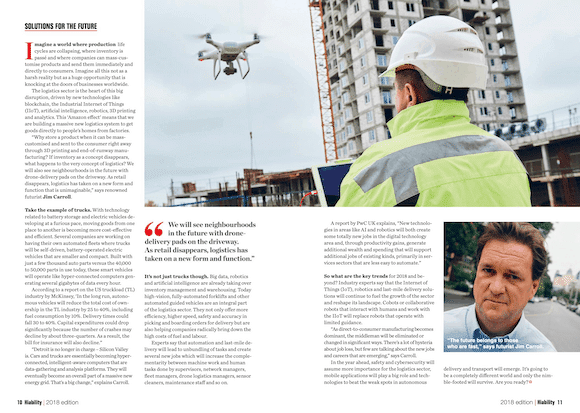The folks at Hiability decided they needed to share with their customers and their industry the fast trends which are disrupting their world. They are one of the world’s leading provider of on-road load-handling equipment, intelligent services, and digitally connected solutions.
And so they found me.
The result was this article, appearing the Hiability Magazine last month. Enjoy!
The intro? “The future belongs to those who’re fast,” says Futurist Jim Carroll, one of the world’s leading futurists and an expert on trends and innovation. As the line between technology companies and traditional companies blur, everything we know about business from retail to inventory all disappear. How can the logistics, transport and material handling sector cope with this eventuality? Let’s fine out.”
Read the PDF, or click on an image. The full text follows below.
The future Is Now!
Hiability Magazine, September 2018
by Payal Bhattar
‘The future belongs to those who are fast’, says Jim Carroll, one of the world’s leading futurist and trends & innovation expert. As the lines between technology companies and traditional companies blur, everything we know about business from retail to inventory will disappear. How can the logistics, transport and material handling sector cope with this eventuality? Find out.
—-
Imagine a world where production lifecycles are collapsing, where inventory is passé and where companies can mass customize products and send them immediately and directly to consumers. Imagine all this not a harsh reality but a huge opportunity that is knocking at the doors of businesses worldwide.
The logistics sector is the heart of this big disruption. Driven by new technologies like blockchain, the Industrial Internet of Things (IIoT), Artificial Intelligence, robotics, 3D printing and analytics. This ‘Amazon effect’ means that we are building a massive new logistics system to get goods directly to people’s homes from factories.
“Why store a product when it can be mass customized and sent to the consumer right away through 3D printing and end-of-runway manufacturing? If inventory as a concept disappears, what happens to the very concept of logistics? We will also see neighbourhoods in the future with drone-delivery pads on the driveway. As retail disappears, logistics has taken on a new form and function that is unimaginable,” says Jim Carroll.
Data is King
Take the example of trucks. With technology related to battery storage and electric vehicles developing at a furious pace, moving goods form one place to another is becoming more cost-effective and efficient. Several companies are working on having their own automated fleets where trucks will be self-driven battery-operated electric vehicles that are smaller and compact. Built with just a few thousands auto parts versus the 40,000 to 50,000 parts today these smart vehicles will operate like hyper-connected computers generating several gigabytes of data every hour.
According to a report on the US truckload (TL) Industry by McKinsey, In the long run, autonomous vehicles will reduce the total cost of ownership in the TL industry by 25 to 40 percent, including fuel consumption by 10 percent. Delivery times could fall 30 to 40 percent. Capital expenditures could drop significantly because the number of crashes may decline by about three-quarters. As a result, the bill for insurance will also decline.’
“Detroit is no longer in charge – Silicon Valley is. Cars and trucks are essentially becoming hyper-connected intelligent-aware computers that are data-gathering and analysis platforms. They will eventually become an overall part of a massive new energy grid. That’s a big change”, explains Jim Carroll.
In Focus: Last-mile Delivery
It’s not just trucks, big data, robotics and artificial intelligence are already taking over inventory management and warehousing. Today high-vision fully automated forklifts and other robotic and automated guided vehicles are an integral part of the logistics sector. They not only offer more efficiency, higher speed, safety and accuracy in picking and boarding orders for delivery but are also helping companies radically bring down the high costs of fuel and labor.
Experts say that automation and last-mile delivery will lead to unbundling of tasks and create several new jobs which increase the complementarity between human tasks and machine work like supervisors, network managers, fleet managers, drone logistics managers, sensor cleaners, maintenance staff etc.
A report by PwC UK explains, ‘new technologies in areas like AI and robotics will both create some totally new jobs in the digital technology area and, through productivity gains, generate additional wealth and spending that will support additional jobs of existing kinds, primarily in services sectors that are less easy to automate.’
Beyond the Horizon / The Need for Speed
So what are the key trends for 2018 and beyond? Industry experts say that the Internet of Things, robotics, last-mile delivery solutions will continue to fuel the growth of the sector and reshape its landscape. Cobots or collaborative robots that interact with humans and work with the Industrial Internet of Things (IIoT) will replace robots that operate with limited guidance.
“As direct-to-consumer manufacturing becomes dominant, the middleman will be eliminated or changed in significant ways. There’s a lot of hysteria about job loss, but few are taking about the new jobs and careers that are emerging, “ says Carroll.
In the year ahead, safety & cyber security will assume more importance for the logistics sector, mobile applications will play a big role and technologies to beat the weak spots in autonomous delivery and transport will emerge. It’s going to be a completely different world and only the nimble-footed will survive. Are you ready?






GET IN TOUCH
Jim's Facebook page
You'll find Jim's latest videos on Youtube
Mastodon. What's on Jim's mind? Check his feed!
LinkedIn - reach out to Jim for a professional connection!
Flickr! Get inspired! A massive archive of all of Jim's daily inspirational quotes!
Instagram - the home for Jim's motivational mind!